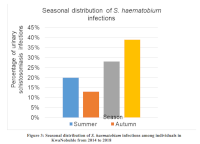A Retrospective prevalence Study of Urinary Schistosomiasis in Nelson Mandela Bay Health District from 2014 to 2018
DOI:
https://doi.org/10.4314/njpar.v45i2.22Keywords:
Prevalence, Schistosoma haematobium, schistosomiasis, KwaNobuhle, South AfricaAbstract
In SouthAfrica (SA) more than 25.7 million people are at risk of infection and over four million people are expected to be infected with the disease. Using secondary data, the prevalence of urinary schistosomiasis was determined retrospectively in KwaNobuhle between 2014 and 2018. Data were obtained from the National Health Laboratory Service (NHLS) of Nelson Mandela Bay Health District
(NMBHD). The findings revealed that there was no significant difference between prevalence and year (p=0.092). The prevalence of urinary schistosomiasis in 2014 was 14 (13%), which increased to 18 (17%), 24 (22%), and 31 (29%) in 2015, 2016, and 2017, respectively; however, it declined to 20 (19%) in 2018. It was further observed that there was a significant (p=<0.0005, V= 0.33 medium) difference found in the prevalence of urinary schistosomiasis infection among males and females from KwaNobuhle. Urinary schistosomiasis infection was higher among males 99 (93%) than females 6 (6%). Furthermore, the highest rate of disease infection was found in individuals between the ages of 10 and 19 years (p<0.0005, V=0.43 medium). There was no significant difference (p=0.156) in the prevalence of urinary schistosomiasis relative to the season over the five years. The results revealed that the rate of urinary schistosomiasis infections within the study area, although not statistically significant, showed an increase from 2014 to 2017 but declined in 2018. It was further found that males had a higher percentage of infections than females, and the highest rate of infections was found in individuals between the ages of 10 and 19 years. Therefore, effective prevention, control, and intervention programs are urgently needed to eliminate schistosomiasis from the study area and avoid possible resurgence.
References
Abou-El-Naga, I. (2018). Towards elimination of schistosomiasis after 5000 years of endemicity in Egypt. Acta Tropica, 181, 112–121. https:doi:10.1016/j.actatropica.2018.02.005
Aribodor, O. B., Mogaji, H. O., Surakat, O. A., Azugo, N. O., Jacob, E. C., Obikwelu, E. M., Nebe, O. J., & Jacobson, J. (2023). Profiling the knowledge of female medical/ para-medical students, and expertise of health care professionals on female genital schistosomiasis in Anambra, Southeastern Nigeria. PLoS Neglected Tropical Diseases, 16;17(2). https://doi.org/10.1371/journal.pntd.0011132
Hambury, S. D., Grobler, A. D., & Melariri, P. E. (2021). Knowledge, Attitudes, and Practices of Urinary Schistosomiasis among Primary Schoolchildren in Nelson Mandela Bay, South Africa. Hindawi Journal of Parasitology Research, 2021, 1–12. https://www.hindawi.com/journals/jpr/2021/6774434/
Maseko, T. S. B., Masuku, S. K. S., Dlamini, S. V., & Fan, C. K. (2023). Prevalence and distribution of urinary schistosomiasis among senior primary school pupils of Siphofaneni area in the low veld of Eswatini:A cross-sectional study. Helminthologia, 4, 60(1):28-35. https://doi: 10.2478/helm-2023-0005.
Mohammed, T., Degarege, A., Aemero, M., Animut, A., Negash, Y., & Erko, B. (2024). Assessment of Urogenital Schistosomiasis Knowledge, Attitudes and Practices Among Abobo Communities in Gambella Regional State, Southwestern Ethiopia. Environmental Health Insights, 18:1-11. doi: 10.1177/11786302241234731
El-Kady,A. M., Sefelnasr,A. M., Osman, D. M. M., Khairallah, M. K.,Abou Faddan,A. H., & Gaber, M. M. (2020). Mapping of Schistosoma Haematobium in Qena District, Qena Governorate, Upper Egypt; Hospital-based Study. Journal of the Egyptian Society of Parasitology, 5(2), 358–363. https://jesp.journals.ekb.eg/article_113058_4d863594c6c9d3255ec6896b28161cc5.pdf
Brindicci, G., Santoro, C. R., De Laurentiis, V., Capolongo, C., Solarino, M. E., Papagni, R., Ciraci, E., Gatti, P., Loconsole, D., Monno, R., Monno, L., Miragliotta, G., & Angarano, G. (2017). Prevalence of Urinary Schistosomiasis in Migrants in Apulia, a Region of Southern Italy, in the Years 2006–2016. Hindawi BioMed Research International, 1–6. https://doi.org/10.1155/2017/8257310
Houmsou, R. S., Panda, S. M., Elkanah, S. O., Garba, L. C., Wama, B. E., Amuta. E. U., & Kela, S. L. (2016). Cross-sectional study and spatial distribution of schistosomiasis among children in North-Eastern Nigeria. Asian Pacific Journal of Tropical Biomedicine, 6(6), 477–484.
https://dx.doi.org/10.1016/j.apjtb.2016.04.003
Kouadio, J. N., Giovanoli, E. J., Sékré, J. B. K., Achi, L. Y., Ouattara, M., Hattendorf, J., Balmer, O., 477 Nigerian Journal of Parasitology
Bonfoh, B., Zinsstag, J., Utzinger, J., & N’Goran, E. K. (2023). Prevalence and risk factors of schistosomiasis and hookworm infection in seasonal transmission settings in northern Côte d’Ivoire: A crosssectional study. Prevalence and risk factors of schistosomiasis and hookworm infection in seasonal transmission settings in Northern Côte d’Ivoire: PLoS Neglected Tropical Diseases, 17(7): e0011487. https://doi.org/10.1371/journal.pntd.0011487
Nwoko, O. E., Manyangadze, T., & Chimbari, M. J. (2023). Spatial and seasonal distribution of human schistosomiasis intermediate host snails and their interactions with other freshwater snails in 7 districts of KwaZulu-Natal province, South Africa. Scientific Reports, 13, 7845. https://doi.org/10.1038/s41598-023-34122-x
Adenowo, A. F., Oyinloye, B. E., Ogunyinka, B. I., & Kappo, A. P. (2015). Impact of human schistosomiasis in Sub-Saharan Africa. The Brazilian Journal of Infectious Diseases, 19(2), 196–205. https://doi.org/10.1016/j.bjid.2014.11.004
Appleton, C. C., & Naidoo, I. (2012). Why did schistosomiasis disappear from the southern part of the Eastern Cape? South African Journal of Science, 108(12), 1–11. https://doi.org/10.4102/sajs
Ghieth, M.A., & Lotfy,A. M. (2017). Schistosomiasis haematobium prevalence among haematuric patients: Parasitological and immuno-assay. Beni-Suef University Journal of Basic and Applied Sciences, 6 83–86. https://www.sciencedirect.com/science/article/pii/S2314853516302062
Njikho, S. L., Quan ,V. C., Mbonane, T. P., & Van Wyk, R. H. (2023). Evaluating the Prevalence and Risk Factors of Schistosomiasis Amongst School-Aged Children in Low- and Middle-Income Communities: Ehlanzeni District Municipality, South Africa, 2015-2021. Tropical Medicine and Infectious Disease, 17, 8(12):522. https://doi:10.3390/tropicalmed8120522.
Ogbonna, C. C., Dori, G. U., Nweze, E. I., Muoneke, G., Nwankwo, I. E., & Akputa, N. (2012). Comparative analysis of urinary schistosomiasis among primary schoolchildren and rural farmers in Obollo–Eke, Enugu State, Nigeria: Implications for control. Asian Pacific Journal of Tropical Biomedicine, 796–802. https://doi.org/10.1016/S1995-7645(12)60146-1
Ansha, M. G., Kuti, K. A., & Girma, E. (2020). Prevalence of Intestinal Schistosomiasis and Associated Factors among School Children in Wondo District, Ethiopia. Hindawi Journal of Tropical Medicine, 1–8. https://doi.org/10.1155/2020/9813743

Downloads
Published
How to Cite
Issue
Section
License
Copyright (c) 2024 Nigerian Journal of Parasitology

This work is licensed under a Creative Commons Attribution-NonCommercial-NoDerivatives 4.0 International License.




